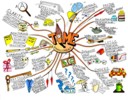KINDS OF NOUNS
Proper Nouns and Common Nouns
Proper nouns are nouns that represent a unique entity (like a specific person or a specific place).
Common nouns which describe an entire group of entities (examples would be the nouns village or women).
Proper nouns as a general rule are capitalized in the English language. Common nouns as a general rule are not capitalized.
Sometimes the same word can function as both a common noun and a proper noun, where one such entity is special. For example the common noun god refers to all deities, while the proper noun God specifically refers to the monotheistic God.
Countable and Uncountable or Noncount Nouns
Countable nouns are common nouns that can become a plural. They can combine with exact numbers (even one, as a singular) or indefinite numbers (like "a" or "an").
Uncountable (or noncount) nouns are different from by the simple fact that they can't become plural or combine with number words. Examples from English include "indigestion" and "furniture".
Collective Nouns
Collective nouns name groups consisting of more than one individual or entity. The group is a single unit, but it has more than one member. Examples include "family", "committee", "corporation","faculty", "army", and "school".
Concrete Nouns and Abstract Nouns
Concrete nouns refer to their ability to register on your five senses. If you can see, hear, smell, taste, or feel the item, it's a concrete noun.
Abstract nouns on the other hand refer to abstract objects such as ideas or concepts, like the nouns "politeness" or "hatefulness".
Possessive Nouns
A possessive noun is a noun that names who or what has something. The possessive form is used with nouns referring to people, groups of people, countries, and animals.
It also refers to where someone works or plays or spends their time.
Add an apostrophe and s ('s) to form the possessive of most singular nouns (ex. Bob's jacket, the cat's tail, Steven King's books).
Add an apostrophe (') to form the possessive of plural nouns that end with s (ex. retailers' stores, soldiers' weapons, Americans' banks).
Add an apostrophe and s ('s) to form the possessive of plural nouns that do not end with s (ex. geese's nest, children's toys, women's dresses).
















